The streets are alive and kicking! Dorothy Max Prior is out and about in Great Yarmouth, for the Out There Festival of Circus and Street Theatre 2019
An experimental circus show in a secret garden with pink-lit trees, from which a woman hangs by her hair. Gaming arcades outwitted by an Actual Reality Arcade, in which small children get thwacked with rubber mallets by their siblings. A web of string animated by light and sound and physical action. Musicians wheeled (or wheeling themselves) though the streets on adapted instruments. And whole posses of acrobats and clowns, both slapstick and sophisticated, entertaining happy hordes of people enjoying the last of the summer sunshine. Welcome to Great Yarmouth, on an untypical weekend in September…
Out There, now in its 12th edition, has all the qualities of a great street arts festival. It’s within a geographically confined space – town centre and seafront, and the immediate streets and parks close to the festival hub at Drill House – so you can easily walk to everything. It’s an international programme, with work from across Europe, including a specially curated group of Catalan companies – and in some cases further afield: the string-web installation referenced, It’s Not Here, It’s Over Here, is by Korean company Galmae. And it nurtures local involvement, with artists and performers from Great Yarmouth, such as the Portuguese collective Reprezent, and local youth groups such as the SeaChange Arts’ Drillaz Circus School, presenting work.
Add in to all that an excellent Festival Professional Programme (Rise Up) for artists, producers and bookers of outdoor arts; a swathe of excellent workshops, from block printing with Extinction Rebellion and Paris 68 Redux, to informal juggling sessions; plus day-long family-friendly craft sessions and circus drop-ins at Drill House – and you’re on to a winning formula.
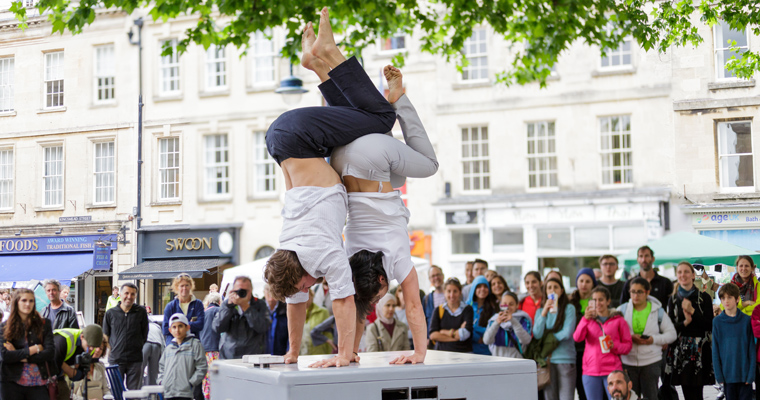
Inverted Theatre: Box. Photo Paul Blakemore
The festival’s full moniker is Out There International Festival of Circus & Street Arts – so there is, naturally, a strong emphasis on circus work. And we find all sorts here, of every scale and style. The six-strong daredevil team of La Contrabande present a crowd-pleasing piece called Bal Trap, which features teeter-board, trampolining, knife-throwing – including a great balloon-popping-from-afar skit – and a lovely section on a low-strung swing cum trapeze. It’s high energy, thrilling stuff as the team of human pinballs leap and bound and bounce on and over the equipment and each other. Carefully-honed physical skills, immaculate timing, and a brilliant sense of (slapstick) humour make for a top-quality show that is about nothing other than what you see – which is good enough for me!
In complete contrast, Inverted Theatre’s Box (a SeaChange Arts co-production) gives us a delicately funny and endearing duet about sibling relationships, using acrobatics and hand-balancing. It’s all set around – yes, you’ve guessed – a box, from which the twinned performers (one boy, one girl, of similar build) emerge. There are little doors, and holes through which to wave – all exploited skilfully. There’s a playful exploration of human shape and form in relation to the box, and to each other. There is a pole that pulls out from the box, used to walk along and hand-balance on, and they also balance on the box itself, on canes on top of the box, and of course on each other. They work beautifully together, bodies entwined like puppies, or pulling away churlishly. Push and pull, give and take is a constant motif. They handstand in such close proximity that they end up almost spooned together, or they balance precariously on opposite sides, right at or over the box’s edge. Skilful and whimsical, with a lovely relationship to audience, who are played to and high-fived as the rivalry between the ‘twins’ builds, Box is an absolute delight, full of gentle surprises.
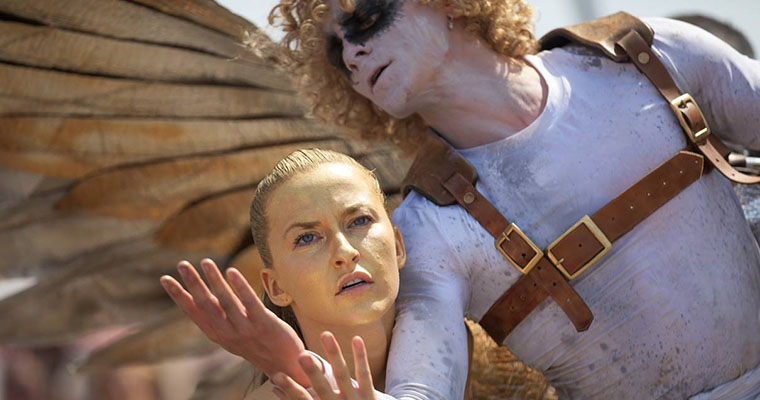
Southpaw Dance Company: Icarus
On the same site as Box, a closed street that adjoins the park, I see Southpaw’s new show Icarus. It’s an ensemble dance-theatre piece, and like other Southpaw work, doesn’t shy away from delivering dance with a strong narrative element. Of course, the Icarus story is very well known, so they don’t have to work too hard to tell the tale, extracting key elements and transposing them into movement motifs and visual imagery, rather than labouring the story with too much detail. The Sun is a woman sporting gold make-up who doesn’t look quite have the gravitas to convince me she is an all-powerful ‘goddess’, and her costume is a little weak (too ‘basic contemporary dance’) to convince us she’s a personification of the mightiest element in our world – but she’s a good dancer, and her majestic rise and fall at the start and end of the day are nicely acted out in a contact dance/hand-to-hand sequence in which she climbs up onto shoulders, then down to the ground over the offered bodies of the chorus. The ill-fated boy Icarus is dressed in white, and the supporting cast are clothed in black tunics dusted with white chalk, with faces made up (evoking classic Greek Mime) in white and black. Icarus’ father Daedalus is, we presume, represented by the all-male chorus, who – having executed a well choreographed ensemble dance with flags and break-dance elements – lift him into his wings, encouraging him to fly high. And what lovely wings they are, enormous gold-and-silver metal structures, each placed individually on to the dancer’s body, supported by a leather harness. The image of the doomed Icarus joyfully exploring the possibilities that his wings afford is delightful, and although the subsequent disastrous encounter with the Sun feels a bit hackneyed to me, smoke billowing all over the place as Icarus falls, the crowd obviously love it. This is not my favourite Southpaw show – apart from anything else, I have seen so many physical/visual theatre versions of the Icarus tale I’m not sure there is room in my heart for another one. But it is, as with all the company’s work, choreographed with care and performed with skill – Samuel Baxter as Icarus, in particular, is a charismatic and talented dancer.
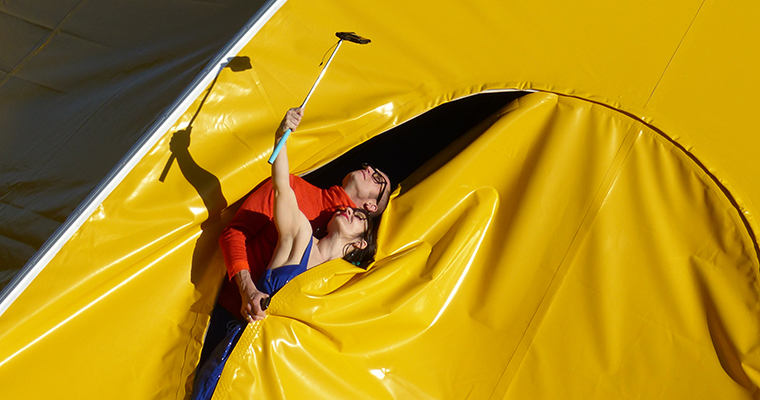
Cia Paki Paya: Toca Toc
As a specially curated body of work within the festival, developed in collaboration with the Institut Ramon Llull, the Catalan programme features an excellent body of (mostly circus) work, by five different companies who are either based in Catalunya, or are international collaborations with Catalan artists. They include the aforementioned secret garden hair-hanger, in Colletivo Terzo Livello’s site-responsive exploration of Yarmouth’s ‘dissenters’ graveyard’, Documento; PakiPaya’s zany tented show, Toca Toc, an exploration of love and partnership, within and outside of the circus relationship; and Cie Soon’s Gregarious, a two-man investigation of sporting rivalry and male friendship, presented on the main stage in the park, which rather wonderfully dares to play with and deconstruct the forms it uses (acrobatics, teeterboard, and Chinese pole). There is also Catalan-Portuguese artist Dulce Duca, who has an outrageously funny new take on juggling on Sweet Drama, a collaboration with local skateboarders co-written by local hero Joe Mackintosh; and a delightful and heartwarming walkabout show about migration, Petjades, by Pau Palaus. All five shows are of a very high standard. (They will be reflected on more fully in a special article about the Anglo-Catalan connection.)
Out There features another curated programme within the programme, in the form of work commissioned by Without Walls, a partnership of festivals and organisations that includes Out There producers SeaChange Arts. Shows presented here in Great Yarmouth includes circus-dance piece Wild by Motionhouse, parkour theatre On Edge by Justice in Motion, Matthew Harrison’s Actual Reality Arcade, and Ray Lee’s Congregation – which have all been seen elsewhere around the country by Total Theatre Magazine in summer 2019.
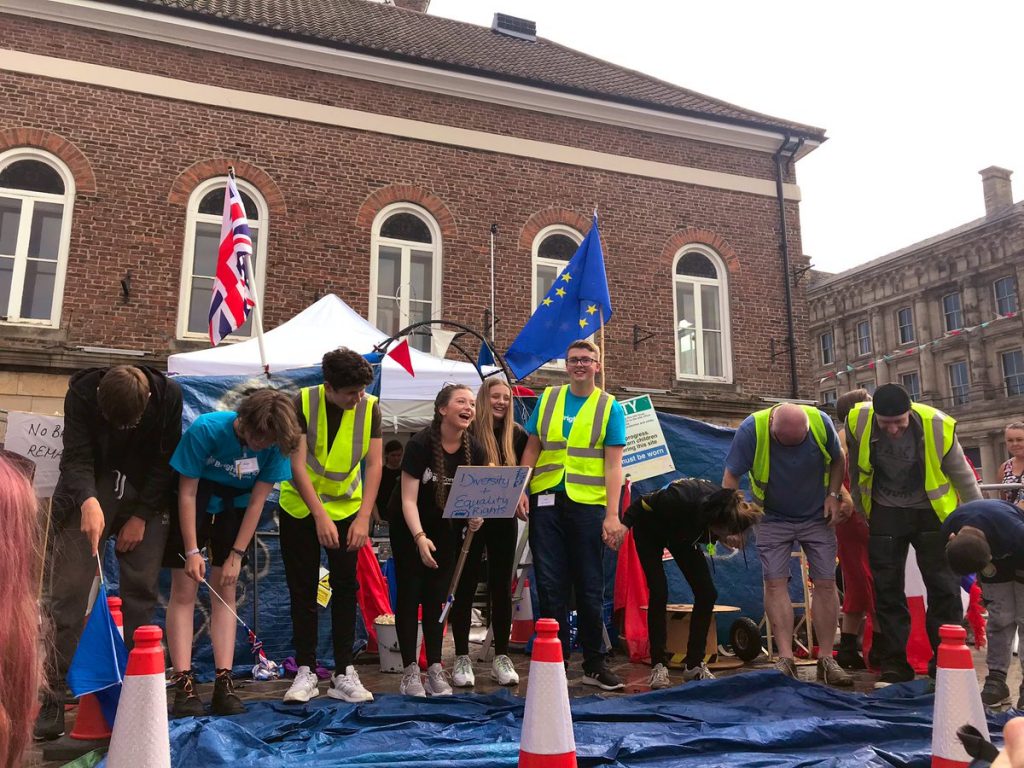
Spitz & Co: Les Gloriables
Also part of Without Walls, and a SeaChange co-production, is a French/UK collaboration from Spitz & Co, Les Gloriables. And what a glorious thing it is! Two women, one French, one English, give us a feisty feminist reworking of Les Miserables, complete with a massive supporting cast – yes, us, the audience, who are brought in as Gilets Jaunes, flag-bearers, placard-writers, angry men (of any gender), weeping women (ditto), and nuns (cue the excruciating 1960s hit ‘Dominique’). Oh and of course we are the baying crowd at the barricades – Viva La Revolution! The whole thing is carried by our trusty narrator ‘Josephine’, who also steps in to play supporting roles (policemen, judges, prison wardens etc.), and the ‘legendary French actress Gloria Delaneuf’ who plays all the main roles – so, an actress plays an actress, playing a multitude of roles, in a kind of nesting Russian doll structure. Gloria has ‘Dreamed a Dream’ (cue song, you know the one), and that dream is ‘to make a piece of theatre that will unite Europe’. The Union Flag and the EU’s blue and yellow emblem fly behind her.
Thus, reformed convict Jean Valjean becomes Jeanne, with a defyingly liberated left breast, and her prisoner number, 24601, emblazoned on the back of her jacket. Later, she morphs into the poor dear impoverished Fantine, who in desperation sells her hair and her front teeth (a nice nod towards the Victor Hugo book – in the musical Les Mis, it’s her hair and a locket), then, as she is forced into prostitution, lap-dances around an elderly gentleman tempted in from the audience. There’s a lovely scene as Fantine is harassed by the dandy Barmatabois, ‘Gloria’ playing both characters, in Music Hall style half-and-half drag. But oh dear, Fantine is on her last legs and wastes away – what will happen her poor dear little illegitimate daughter, Cosette? Jeanne to the rescue!
It’s Poor Theatre of the best sort. A porter’s trolley serves multiple purposes, the Paris Uprising is enacted with water bombs, and a basket full of white handkerchiefs are not only hankies but also flags and nuns’ wimples. And who needs a swanky theatre in the West End or on Broadway when you have the Market Place in Yarmouth (right next to the Market Chips stall too – an added bonus).
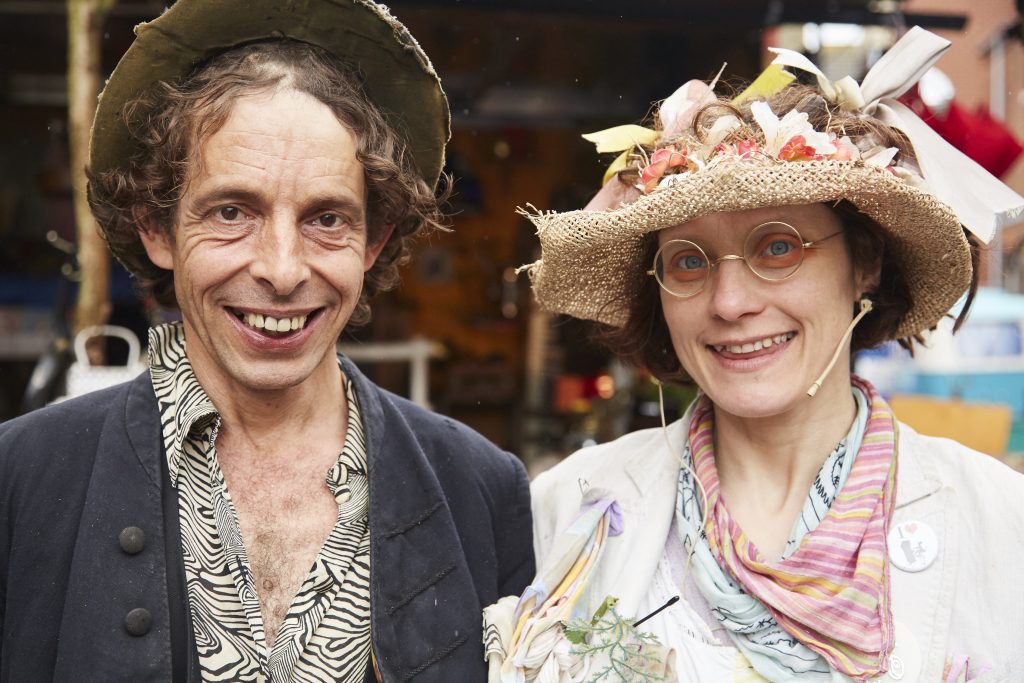
Rimski & Handkerchief
Another favourite show is also a SeaChange co-production, Rimski & Handkerchief’s Wind Up at Home. It’s a musical installation piece, a kind of arty bric-a-brac stall, placed (rather wonderfully, I feel) not in a cobbled backstreet full of quirky run-down shops – and there are a fair few of those in Yarmouth – where it would blend in with its surroundings, but right slap bang in the middle of the most redeveloped part of the town, next to the bus station and the Market Gates shopping centre. It looks magnificently incongruous in its chosen site. We see an open-fronted shoplet bursting to the brim with tattered objects, piled one upon the other, and escaping out onto the pavement. There’s a velvet chaise longue heaped with eiderdowns and cushions, an assortment of chairs and occasional tables of all shapes and sizes, and lamps a-plenty, many with the sort of fringed shades your granny would love. There’s a little wooden rocking horse, rusty Silver Cross prams, well-loved large-horned musical instruments, a gramophone player bearing a miniature band on its turntable, and a wax skull wearing a policeman’s hat. There are hostess trolleys loaded with a crazed assortment of lanterns, tin pots, crockery, and fake flowers – yellow dahlias! – and there are lots of whirring umbrellas of all sizes and colours. And it’s not just the umbrellas – things whir and tick and clunk all over the place. Oh, not to mention the ringing telephones… Meanwhile, a pair of odd looking characters, one male, one female, potter around. He’s in a faded and frayed black suit and battered hat. She’s in a Victorian white cotton playsuit-type undergarment with odd socks, brown brogues, and an equally battered hat sporting fake flowers.
To each side of Rimski’s Yard (as the sign pronounces) are two interesting musical instruments. There’s a piano on bicycle wheels, with a ripped and torn faded pink velvet seat and klaxon horn (the aptly named Bicycle Piano); and there’s a double bass mounted on to a tricycle (the Double Bassicle). A couple of times a day, the installation is augmented by musical performances, Rimski and his ‘partner in rhyme’ Handkerchief taking to their instruments to serenade us. At the start of their final show of the festival, Rimski frantically peddles up and down the pavement whilst playing the old honky tonk, and Handkerchief suddenly pops out of the piano’s top lid. Together, they sing Send in the Clowns (of course they do!) and the Flanagan & Allen classic, Nice People, amongst other treats. Handkerchief also has a brief spell on her double bass, which she describes as ‘broken’. The crowd love them – especially when Rimski veers into the road with his piano and does nothing to avoid an oncoming double-decker that has just turned out from the bus station. Rimski stops, heaving on the great metal handbrake that clunks noisily. The bus driver stops – just in time – and Rimski then slowly, pumping furiously, pedals away to cheers and laughter from the crowd. Meanwhile, the umbrellas whir on, and the installation clunks away in the background. It is all as eccentrically English as you could possibly imagine –installation and performance are a complete delight, both.

Mark Copeland: 21 Remarkable People (& An Angler)
Also eccentrically English and a total delight is the new project from Insect Circus creator, Mark Copeland – a marvellous wheeze called 21 Remarkable People (& an Angler), which is presented as an exhibition at Skippings Gallery, purportedly portraits of the artist’s ancestors, with a performative element in the form of Mrs Insect Circus (the artist’s wife and collaborator Sarah) who gives us a guided tour of cautionary tales. Thus, we meet a pair of twins conjoined by their hair and nails, a puppeteer who becomes more and more puppet-like – cracked and wooden – as he ages, and a woman who makes a jacket out of the tattooed skin of her drowned sailor husband… The dastardly Angler, by the way, is excluded from the ‘remarkable’ list as he is responsible for the death of the very last mermaid, which he catches and shows off with crude boasting.
The festival’s 2019 professional programme, Rise Up, includes a day reflecting on art activism, with a keynote speech from Extinction Rebellion’s Charlie Waterhouse; and a Total Theatre Talks session entitled The Future is Ours: a positive approach to Eco Theatre and Sustainability.
Tying in to the Rise Up! theme, the Saturday night whole-town showpiece of the festival is a major new show from French outdoor arts veterans Generik Vapeur, working in collaboration with UK company Gorilla Circus to create Thank You for Having Us (reviewed here), co-commissioned by the festival’s producers, SeaChange Arts.
Which feels a good note to end on – thank you indeed, Out There Festival– it has been a pleasure.
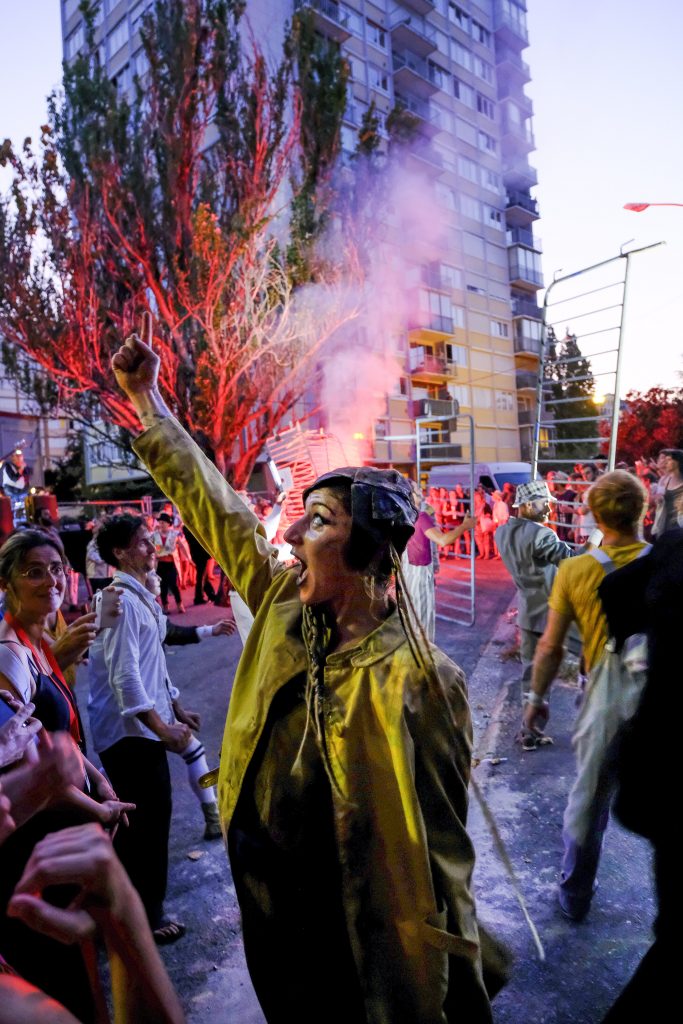
Générik Vapeur/ Gorilla Circus: Thank You for Having Us
Featured image (top): Spitz & Co: Les Gloriables.
Out There International Festival of Circus & Street Arts, 14–15 September 2019: www.outtherefestival.com

